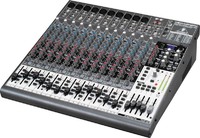Basic operation of a two-track (stereo) Mixing Panel
Mixing panels are like automobiles. Once you learn how to operate one model, you discover that other makes and models are fairly similar. Some of the buttons may be in different places, but the operating principles are pretty much the same.
 Mixing panels are described as the number of inputs by the number of outputs. For instance, a 6x2 board would mean that there are six inputs that can be mixed and assigned to two outputs (aka stereo).
Mixing panels are described as the number of inputs by the number of outputs. For instance, a 6x2 board would mean that there are six inputs that can be mixed and assigned to two outputs (aka stereo).
Beware that some manufacturers label their mixers in a misleading manner: they count RCA or ¼-inch stereo line inputs as well as normal XLR mic inputs in their "names" or specs. Read carefully to see how many actual XLR MICROPHONE inputs the board actually has. For our purposes, these XLR MIC inputs are the only ones that count.
A board described as 10x4x2 would translate into ten inputs, assignable to four outputs, and also eventually assignable to just two outputs. I use a board like this, the Xenyx 2442FX manufactured by Behringer (see illustration), so that I can mix to a four-track timecode recorder on my cart (intended for the sound editor) as well as being able to send a two-track version to the camera (for dailies and picture edit).
Note that when a board is described as two output, it does not literally mean that there are only two output connectors. Most mixing boards offer two or three sets of output connectors (XLR, ¼-inch, RCA) so that you can feed multiple devices at the same time. Otherwise, just use simple "Y" cables to send an output to two devices if you need to.
Powering
The majority of inexpensive (yet professional grade) mixing panels are designed to operate from regular 117vAC wall outlet. The manufacturers made no provision for internal battery operation or external 12 volt DC, since these boards were intended for musicians. However, it is extremely rare that you would be shooting a dramatic scene or major interview on a set where there was no AC power for lights, monitors, etc.
In the event that you are in a remote location that does not have any electricity available, you can use a common 150watt inverter that converts 12v DC (cig lighter or camera battery) to AC. Spend a few more dollars and purchase a higher quality inverter designed for computers and electronic gear. The cheap models found at the auto parts stores and discount places do not put out as clean a voltage as needed for filmmaking.
Some people complain that when the mixer is run off of the inverter, a little bit of buzz & hum is detectable in the headphones. Personally, I have found that this electronic noise is only noticeable when the mic inputs are turned all the way up (with no mics attached) and the headphone volume is all the way up.
Under actual working conditions, with a mic plugged in, the noise is so low as to be undetectable. Especially in noisy exteriors, such as beaches or mountain tops.
The main power switch for the mixer is on the back. Remember to turn it on. Also, remember to turn on the switch for the Phantom mic powering. You would be surprised at how many folks forget to turn both switches ON and then cannot figure out why there is no sound!
